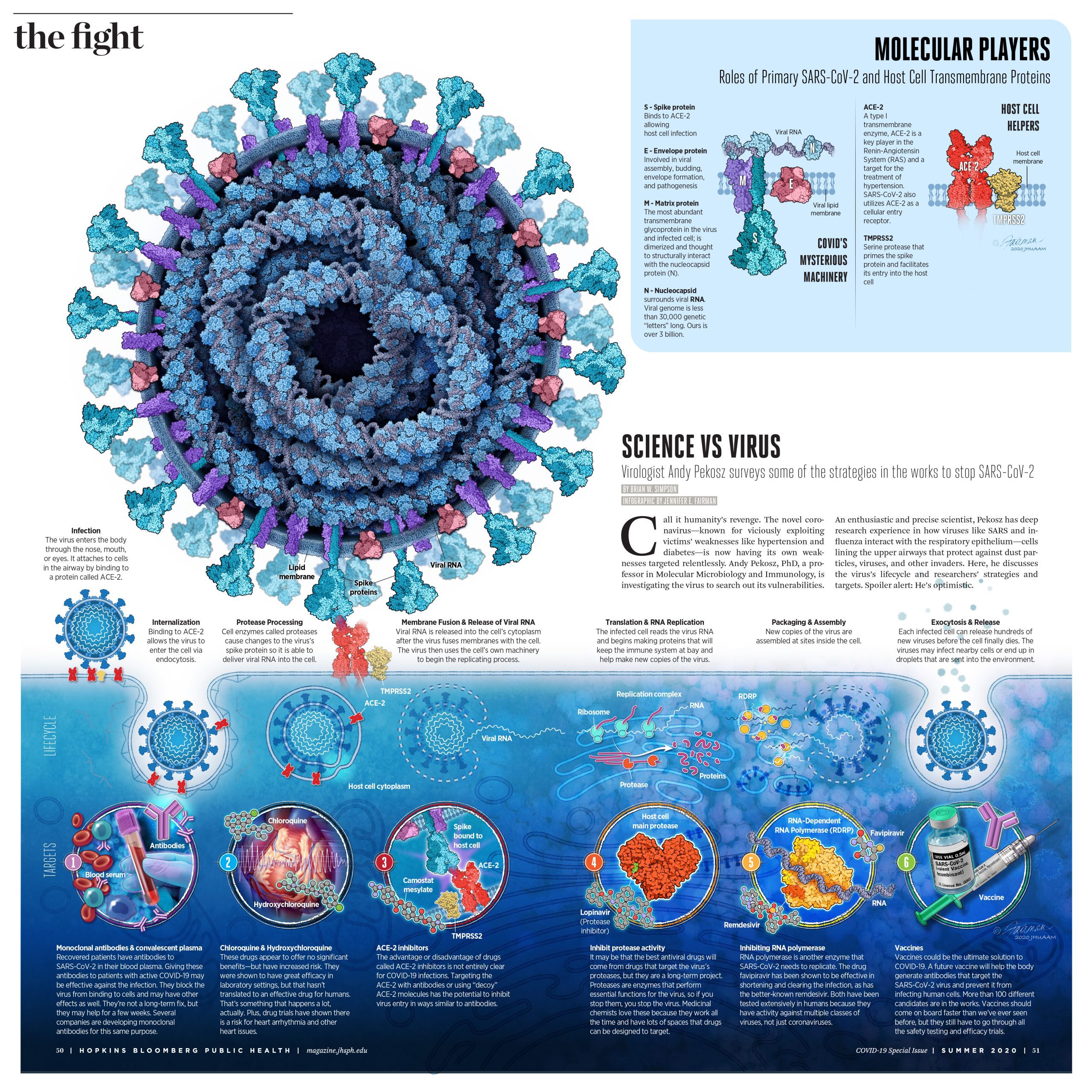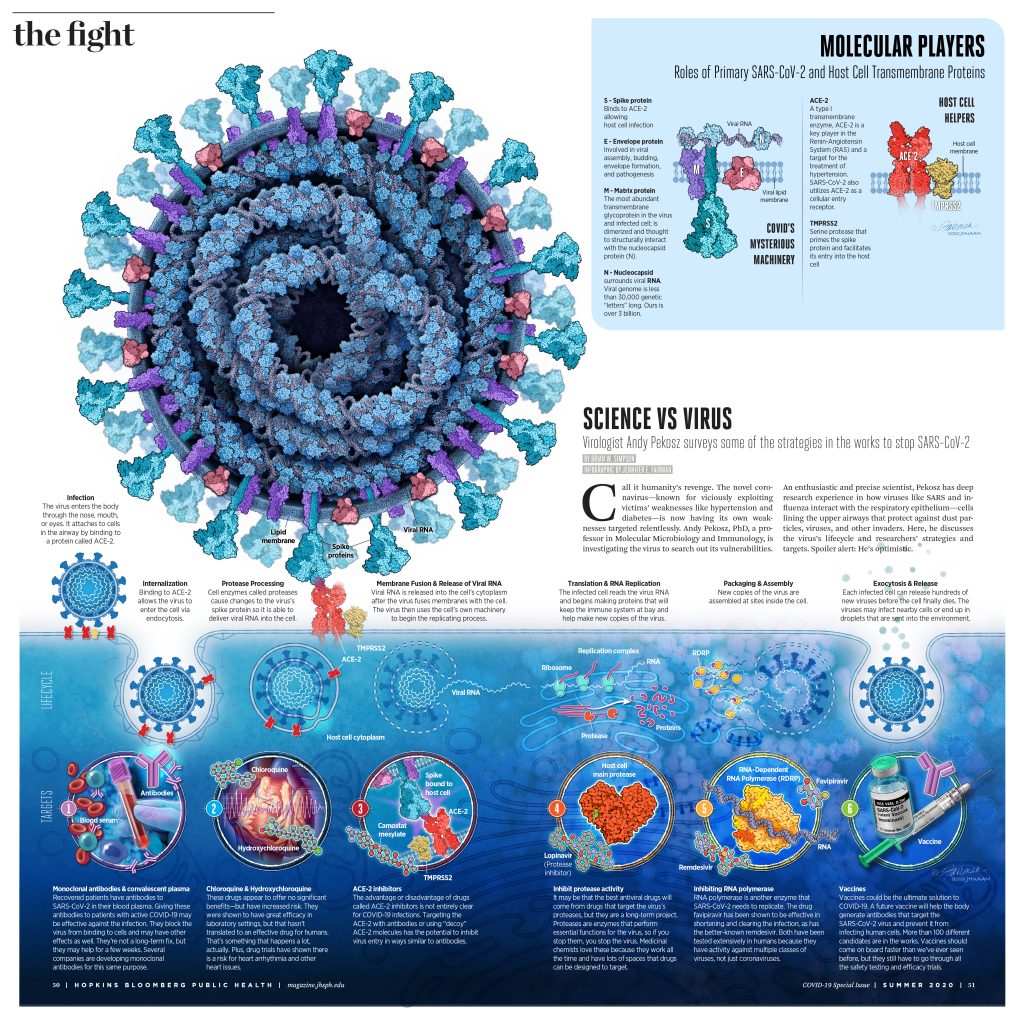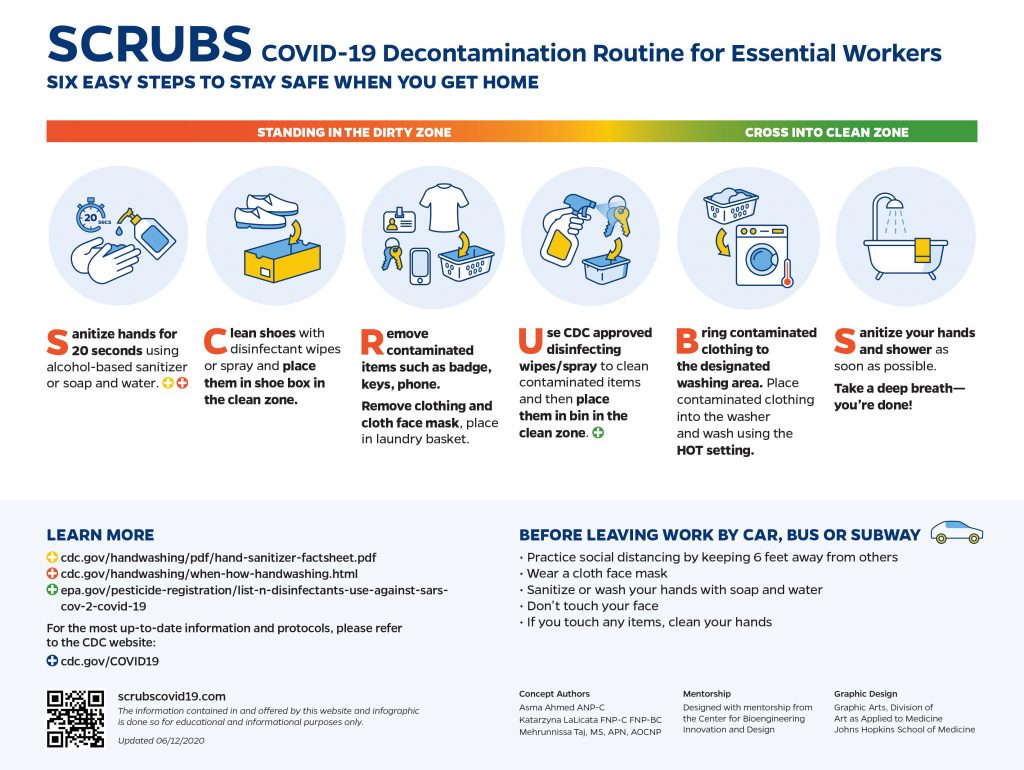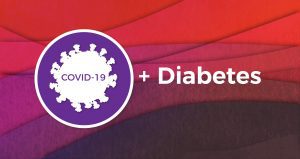With the advent of the SARS-CoV-2 (COVID-19) Pandemic, the Department of Art as Applied to Medicine has never been busier with creating biomedical visuals that communicate it’s many facets to wide audiences. From COVID-19 test kit collection techniques, to the virus structure, targeting it’s lifecycle, understanding how to cope with COVID for diabetes patients, and “hot-zone” procedures, many great collaborations have taken place across campus in partnership with our department. Below is a growing list of examples of ongoing projects involving COVID-19.
School of Public Health: Targeting COVID-19 Infographic with Professor Andy Pekocz
|
Jeni Fairman has been collaborating with Andy Pekosz, and the Bloomberg School of Public Health Magazine to create a 2-page infographic illustrating COVID-19 and potential weak points in the process that can be targeted to intercept the virus during its life-cycle. More details and the final work will be posted here once published. This story and a supplementary animation (left) hit newsstands recently in the July 2020 | COVID-19 Special Issue of the School of Public Health Magazine:
|
CBID Design Challenge
Karen Klinedinst and Kimberly Lawler from Graphic Arts, and Jeff Day form Art as Applied to Medicine collaborated with team members from the CBID COVID-19 Design Challenge to crreate informative materials “SETTING UP YOUR DECONTAMINATION ZONE” for Essential Workers concerned with keeping their homes and loved-ones safe while working in high risk areas for exposure to COVID-19. These posters show how to:
- Designate an area for a decontamination routine and divide it into two zones: dirty and clean.
- The dirty zone should be the area you walk into first.
- Move into your home (clean zone) after your routine.
 |
|
Nasal Swab Video: Respiratory virus testing with the nasal mid-turbinate swab technique
|
While demand for COVID-19 testing increases, providers must adapt testing methods to accommodate inconsistently available swabs and variations in patient’s anatomy. There is limited instructional material on how to obtain a nasal mid-turbinate (NMT) swab. The NMT technique offers flexibility for use of larger swabs and reduced length of swab penetration into the nares. Beginning May 13, all patients being admitted to an inpatient Johns Hopkins Health System facility will be screened and tested for SARS-CoV-2 with the COVID-19 nucleic acid testing (NAT) by nasopharyngeal swab (NP) or nasal mid-turbinate swab. Admissions should not be delayed while awaiting results of COVID-19 tests. For patients who are already admitted and have not yet been tested, please send a test for SARS-CoV-2. This video has been submitted to the New England Journal of Medicine. |
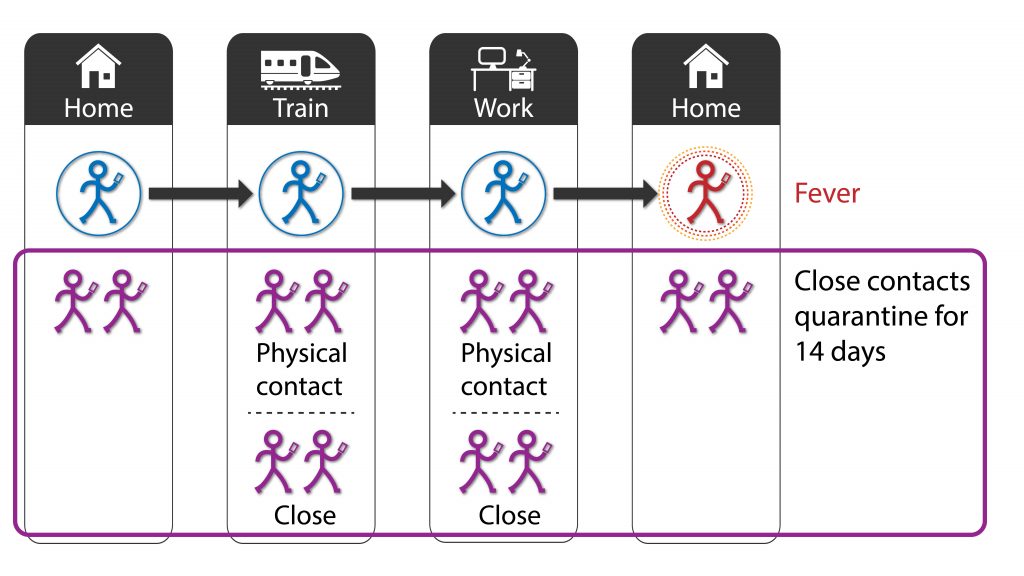 |
Jeff Day helped with diagrams for a COVID-19 contact tracing course on Coursera, created by the Johns Hopkins School of Public Health. The “Tech” image is one that gets animated step-by-step in the course. It illustrates a mobile app working to decrease disease spread. The R0 or Reproduction Number, shows how contagious an infectious disease is. It shows the average number of people that will contract a disease from one contagious person. A Reproduction Number of 1 will see a disease stay steady over time in a population. A Reproduction Number greater than 1 will see a disease will increase over time. And a Reproduction Number of less than one will see a disease wane over time. |
|
While demand for COVID-19 testing increases, providers must adapt testing methods to accommodate inconsistently available swabs and variations in patient’s anatomy. There is limited instructional material on how to obtain a Deep Nasal Swab Self-Collection Kit. For many appointments at Johns Hopkins Medicine, patients will be asked to self-screen for COVID-19 on their mobile device. Patients may also invite their care partner accompanying them to their appointment to virtually screen once the patient has successfully used the tool. Patients scheduled to have a procedure or surgery at a Johns Hopkins facility are required to have a COVID-19 test 24–72 hours before surgery. A coordinator schedules the test at a Johns Hopkins testing facility. If the coordinator determines a patient to be asymptomatic, they will be scheduled for a testing appointment. Based on the chosen testing location patients may be performing a self-test. Patients arrive at a testing site, check in to pick up a kit and instructions, then return to their car to perform the self-test. Upon completion, they will return the kit to a designated drop box at the site. |
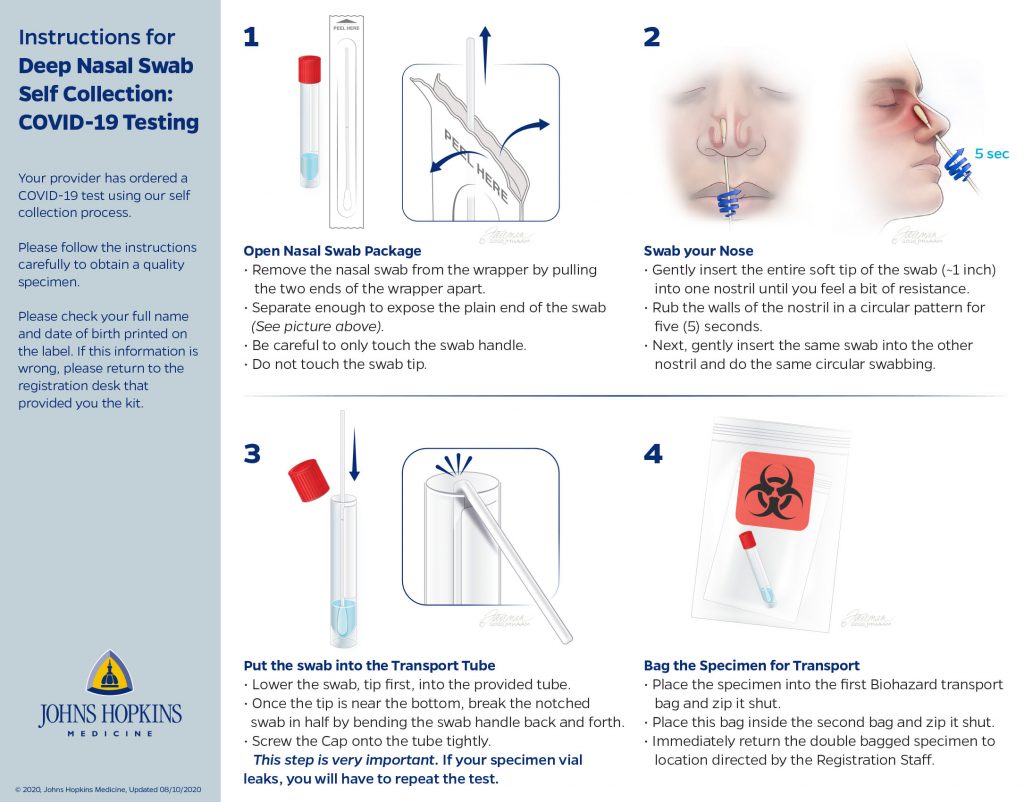 |
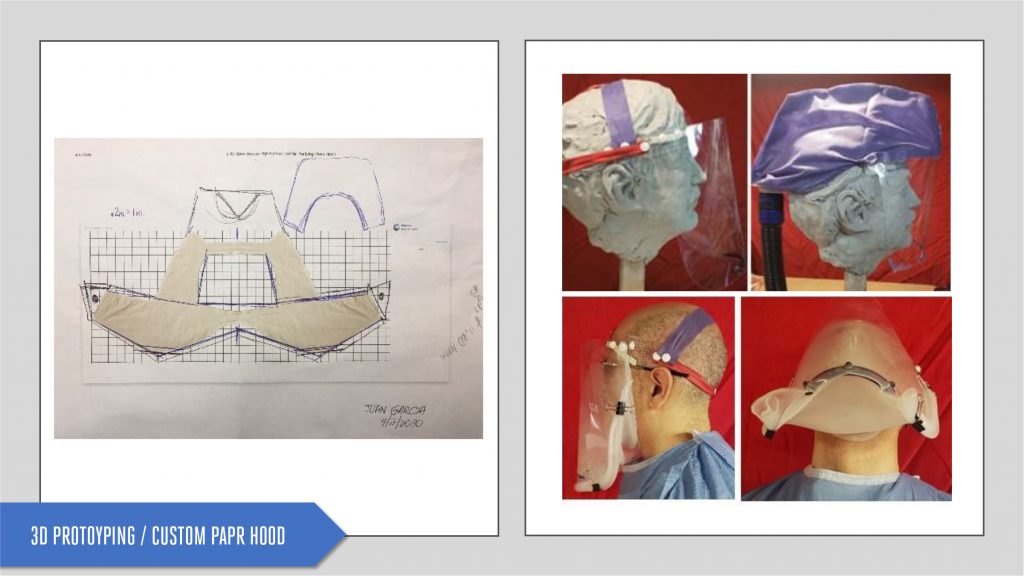 |
Juan Garcia, Associate Professor, Director of the Facial Prosthetics Clinic, and Director of 3D Printing Services, has been working on proposed hood early prototypes for PPE engineering.
These prototypes were provided to the Applied Physics Laboratory in early April and used as basis for APL fabric pattern designs |
AMI Named a top 100 Association that will Save the World!
|
For our response to the coronavirus pandemic, Associations Now has named the Association of Medical Illustrators as one of the top 100 associations that will save the world! We’re honored, and our members, including alumni, faculty and students, will continue to do everything they can to facilitate coronavirus education. Members of the Association of Medical Illustrators banded together quickly to develop timely visual training materials for front-line healthcare professionals responding to the pandemic. “Our field makes invisible things visible,” says Michael Konomos, an Emory University School of Medicine illustrator who serves on AMI’s board of governors. Konomos set up a central repository for information about COVID-19 on AMI’s member hub, which accelerated illustrators’ ability to create and share materials about the virus to improve public health. The collaborative effort highlights the “power of associations” as hubs for knowledge exchange in the professions they represent, says AMI Executive Director Whitney Wilgus. |
 |
COVID-19: Visualizing a Moving Target
|
COVID-19: Visualizing a Moving Target Presented August 8, 2020 at the 2020 GNSI Virtual Conference. Jennifer Fairman, CMI and Associate Professor at the Johns Hopkins University School of Medicine Art as Applied to Medicine Program. Ever since Maryland’s “Stay at home” order, Jeni has been knee-deep in COVID-19 visualizations. Many of her JHU and AMI colleagues have been inundated with COVID-19 assignments in what has seemed like a race to understand the virus structure, life-cycle, and potential therapies. Jeni will share her COVID-19 story by explaining what she and her colleagues have learned and created in order to help the public best understand the current pandemic. (0.5 BIOMED CEUs) |

